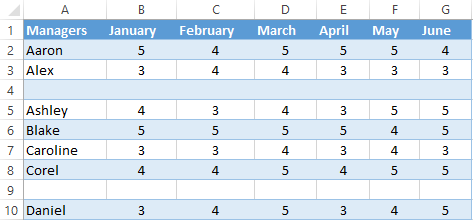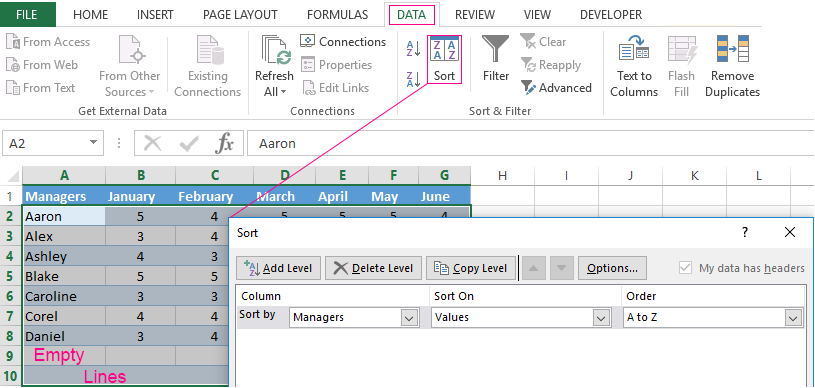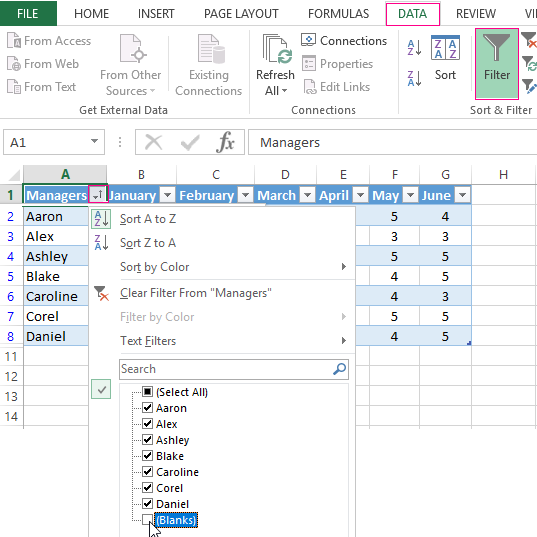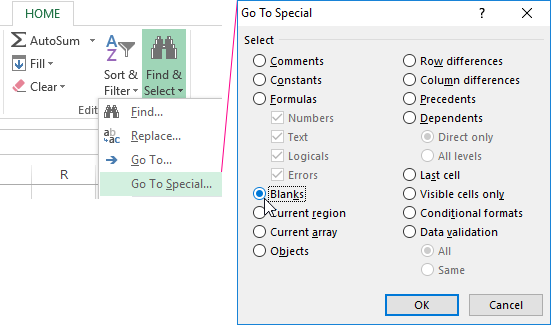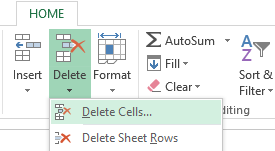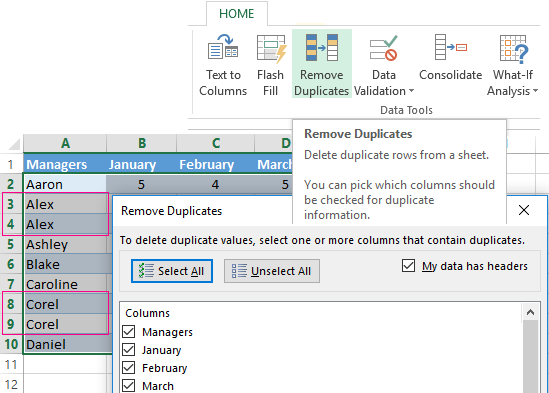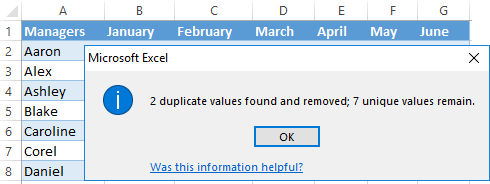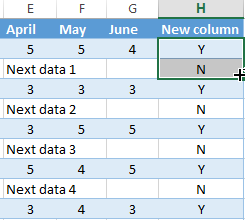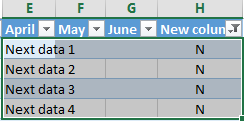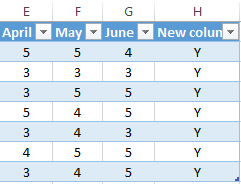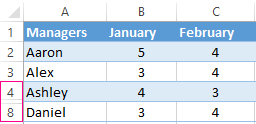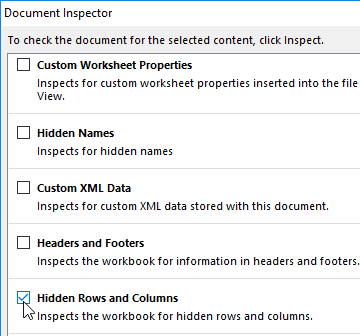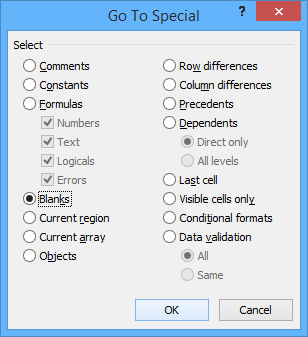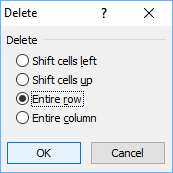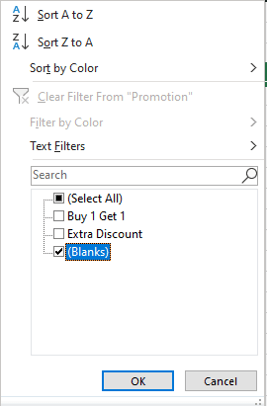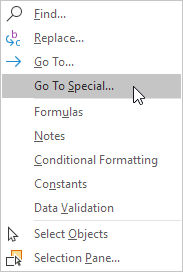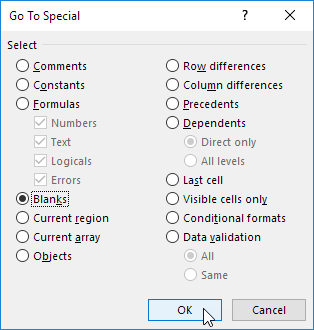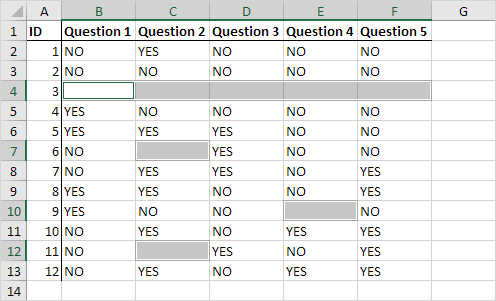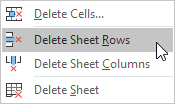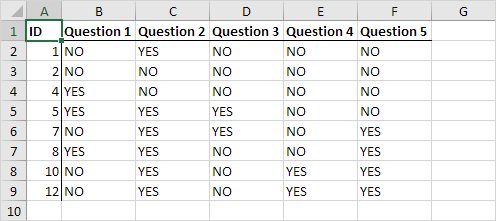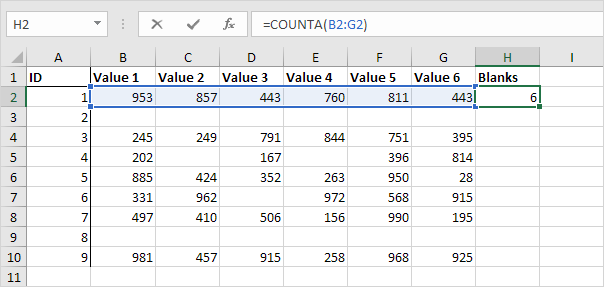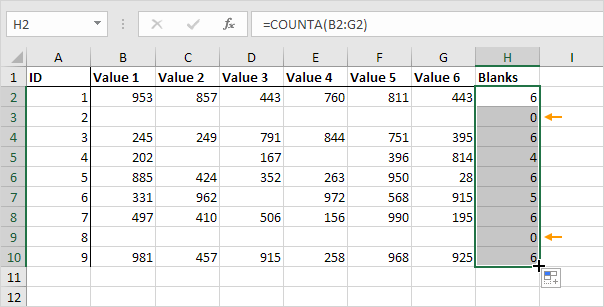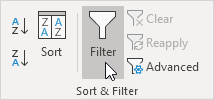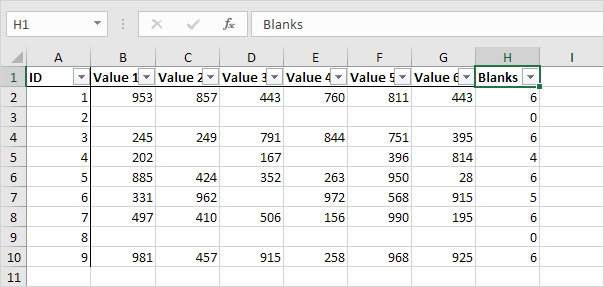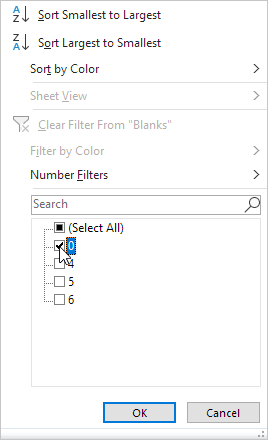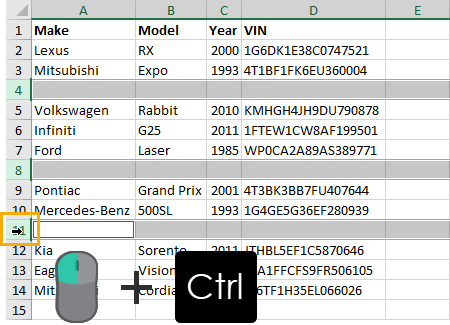When importing and copying tables in Excel, empty strings and cells can be formed. They always district and interfere with the work.
Some formulas may not work correctly. It is impossible to use a number of tools for an incompletely filled range. We will learn how to quickly delete empty cells at the end or middle of a table. We will use simple tools available to the user of any level.
How to remove empty rows in the Excel table?
To show you how to delete extra lines, to illustrate the order of actions, take a table with conditional data:
Example 1: Sorting data in a table. Select the entire table. Open the «DATA» tab — «Sort and Filter» tool — press the «Sort» button. Another way is to right-click on the selected range and do the sorting «A to Z».
Empty rows after sorting in ascending order are at the bottom of the range.
If the order of the values is important, then before the sorting, you need to insert an empty column, make a through numbering. After sorting and deleting blank lines, sort the data by the inserted column with the numbering again.
Example 2: Filter. The range must be formatted as a table with headers. We select the «cap». On the «DATA» tab, we click the «Filter» button («Sort and Filter»). A down arrow appears to the right of each column name. Push — opens the filtering window. Remove the selection in front of the name «Empty».
You can delete empty cells in the Excel line the same way. Select the required column and filter its data.
Example 3: Selecting a group of cells. Select the entire table. In the main menu on the «Edit» tab we click the button «Find and Select». Select the «Go To Special» tool. In the window that opens, select the «Blanks».
The program marks empty cells. On the main page we find the «HOME»-«Delete»-«Delete Cells».
The result is a filled range of «no voids».
Attention! After the removal, some of the cells jump upwards — the data can be messed up. Therefore, for the overlapping ranges, the instrument is not suitable.
Helpful advice! The shortcut to delete the selected row in Excel is CTRL + «-«. And for its selection, you can press the hotkey combination SHIFT + SPACEBAR.
How to remove repeated rows in Excel?
To remove the same rows in Excel, select the entire table. Go to the tab «DATA»-«Data Tool»-«Delete Duplicates».
In the window that opens, select those columns that contain duplicate values. Since you need to delete duplicate rows, all columns should be highlighted. After clicking OK Excel creates a mini-report of the form:
How to remove each second line in Excel?
You can use the macro to break the table. For example, this:
Sub Delete_Every_Other_Row()
' Dimension variables.
Y = False ' Change this to True if you want to
' delete rows 1, 3, 5, and so on.
I = 1
Set xRng = Selection
' Loop once for every row in the selection.
For xCounter = 1 To xRng.Rows.Count
' If Y is True, then...
If Y = True Then
' ...delete an entire row of cells.
xRng.Cells(I).EntireRow.Delete
' Otherwise...
Else
' ...increment I by one so we can cycle through range.
I = I + 1
End If
' If Y is True, make it False; if Y is False, make it True.
Y = Not Y
Next xCounter
End Sub
And you can do it by hand. We offer a simple way, accessible to each user.
- At the end of the table, make an auxiliary column. Fill with alternate data. For example, «N Y N Y», etc. We enter values in the first four cells. Then select them. «We catch» for the black cross in the lower right corner and copy the letters to the end of the range.
- Install the «Filter». Filter the last column by the value of «Y».
- Select all that is left after filtering and delete.
- We remove the filter — only cells with «N» will remain.
The auxiliary column can be eliminated and operated with a «decimated table».
How to delete hidden rows in Excel?
When the user had hidden some information in the rows he was not distracted from his work. I thought that later the data would be needed. It is not needed — hidden rows can be deleted: they affect the formulas, interfere.
In the training table are hidden rows 5, 6, 7:
We will remove them.
- Go to «FILE»-«Info»-«Check for Issues» the tool «Inspect Document».
- In the opened window, put a tick in front of the «Hidden Rows and Columns». Click «Inspect».
- After a few seconds, the program displays the result of the test.
- Click «Remove All». A corresponding notification will appear on the screen.
As a result of the work done, the hidden cells are deleted, the numbering is restored.
Thus, remove the empty, repeating or hidden cells of the table using the built-in functionality of the Excel program.
Easy Ways to Remove Blank or Empty Rows in Excel
by Avantix Learning Team | Updated April 5, 2021
Applies to: Microsoft® Excel® 2010, 2013, 2016, 2019, 2021 and 365 (Windows)
You can delete blank rows in Excel using several tricks and shortcuts. Check out these 5 fast ways to remove blank or empty rows in your worksheets.
In this article, we’ll focus on methods that work with all versions of Excel. In future articles, we’ll take a look at other methods available in Excel 365.
Here, we’re assuming your data is in ranges of cells with data arranged vertically below row headings or field names (and no merged cells). Excel recognizes data arranged in this way as a list or data set (or database). You can also use many of these strategies with Excel tables.
Recommended article: 15 Microsoft Excel Keyboard Shortcuts to Speed Up Formatting
Do you want to learn more about Excel? Check out our virtual classroom or live classroom Excel courses >
If you want to delete one row, you can delete the row manually:
- Select the row. Click its heading or select a cell in the row and press Shift + spacebar.
- Right-click the selected row heading. A drop-down menu appears.
- Select Delete.
1. Deleting blank rows using the context menu
To delete multiple contiguous blank rows using the context menu:
- Drag across the row headings using a mouse or select the first row heading and then Shift-click the last row heading.
- Right-click one of the row headings. A drop-down menu appears.
- Select Delete.
To delete multiple non-contiguous blank rows using the context menu:
- To select non-contiguous rows, click the heading of the first row and then Ctrl-click the headings of the other rows you want to select.
- Right-click one of the row headings. A drop-down menu appears.
- Select Delete.
2. Deleting blank rows using a keyboard shortcut
To delete multiple contiguous blank rows using a keyboard shortcut:
- Drag across the row headings using a mouse or select the first row heading and then Shift-click the last row heading.
- Press Ctrl + – (minus sign at the top right of the keyboard) to delete the selected rows.
To delete multiple non-contiguous blank rows using a keyboard shortcut:
- To select non-contiguous rows, click the heading of the first row and then Ctrl-click the headings of the other rows you want to select.
- Press Ctrl + – (minus sign at the top right of the keyboard) to delete the selected rows.
3. Deleting blank rows by sorting
An easy way to delete blank rows is to sort the data so that blanks appear at the bottom and you can then ignore them.
To delete blank rows by sorting:
- Select the entire range of data (not just the column you want to sort).
- Click the Data tab in the Ribbon.
- Select Sort in the Sort & Filter group. A dialog box appears. Assuming you have a header row, select My data has headers.
- Beside Sort by, select the field or column with the blanks you want to remove and then select the appropriate sorting option (such as A-Z, smallest to largest, ascending or descending) to display blanks at the bottom of the data set.
- Click OK. Blank rows will now appear at the bottom of the data set and can be ignored.
Below is the Sort dialog box:
4. Deleting blank rows using Go to Special to highlight blanks
A great way to remove blank rows in a range of data is to use Go to Special.
The Go To Special dialog box displays the following options:
To find and remove blank rows using Go to Special:
- Select one column where there are blank cells in the column (we’re assuming here that the rest of the row is blank). If there is sensitive data above or below the list that you don’t want to delete, select the cells in the column from the first cell in the range to the last cell in the range (you could click in the first cell and Shift-click in the last cell).
- Press Ctrl + G. The Go To dialog box appears.
- Click Special to display the Go To Special dialog box. Alternatively, you can click the Home tab in the Ribbon and then select Go To Special from the Find & Select drop-down menu.
- Select Blanks in the Go to Special dialog box and click OK. Excel will select all of the blank cells within the selected range.
- Right-click one of the selected blank cells and select Delete. A dialog box appears.
- Select Entire Row.
- Click OK.
The Delete dialog box appears as follows:
Although you can also use the Find command to find blanks, it’s much easier to use Go to Special.
5. Deleting blank rows using filtering
You can also delete blank rows using filtering (traditionally called AutoFiltering).
To delete blank rows using Filter:
- Select the range of cells that includes all of the data in the data set (including blank rows).
- Click the Data tab in the Ribbon.
- Select Filter in the Sort & Filter group. Alternatively, you can press Ctrl + Shift + L. Arrows appear beside the field names.
- Click the arrow beside the field name with the blank cells in rows you want to delete.
- Turn off or de-select Select All.
- Select Blanks. You will likely need to scroll down to select Blanks.
- Select the row headings of the filtered rows by clicking the first row heading and Shift-clicking the last row heading.
- Right-click one of the selected headings. A drop-down menu appears.
- Select Delete Row.
- Click the Data tab in the Ribbon and select Clear in the Sort & Filter group to remove the filtering.
In the example below, the Promotion field is filtered to display blanks:
You will now be able to sort, filter and create pivot tables with the list.
Subscribe to get more articles like this one
Did you find this article helpful? If you would like to receive new articles, JOIN our email list.
More resources
How to Use Flash Fill in Excel (4 Ways with Shortcuts)
How to Lock Cells in Excel (Protect Formulas and Data)
3 Excel Strikethrough Shortcuts to Cross Out Text or Values in Cells
Use Conditional Formatting in Excel to Highlight Dates Before Today (3 Ways)
How to Replace Blank Cells in Excel with Zeros (0), Dashes (-) or Other Values
Related courses
Microsoft Excel: Intermediate / Advanced
Microsoft Excel: Data Analysis with Functions, Dashboards and What-If Analysis Tools
Microsoft Excel: Introduction to Power Query to Get and Transform Data
Microsoft Excel: New and Essential Features and Functions in Excel 365
Microsoft Excel: Introduction to Visual Basic for Applications (VBA)
VIEW MORE COURSES >
Our instructor-led courses are delivered in virtual classroom format or at our downtown Toronto location at 18 King Street East, Suite 1400, Toronto, Ontario, Canada (some in-person classroom courses may also be delivered at an alternate downtown Toronto location). Contact us at info@avantixlearning.ca if you’d like to arrange custom instructor-led virtual classroom or onsite training on a date that’s convenient for you.
Copyright 2023 Avantix® Learning
Microsoft, the Microsoft logo, Microsoft Office and related Microsoft applications and logos are registered trademarks of Microsoft Corporation in Canada, US and other countries. All other trademarks are the property of the registered owners.
Avantix Learning |18 King Street East, Suite 1400, Toronto, Ontario, Canada M5C 1C4 | Contact us at info@avantixlearning.ca
How To Delete Blank Rows In Excel: Step-by-Step (2023)
Everyone hates empty rows in their data.
Fortunately, there are 2 ways to remove all the blank rows in your spreadsheet – in just a few clicks.
Which method fits you best comes down to this really important distinction:
1) “I want to delete rows that contain 1 or more blank cells”
2) “I want to delete rows if they only contain blank cells”
Let’s dive in🤿
Oh, and click here to download the Excel file I’m using in this guide.
How to delete blank rows if 1 or more cells are blank
This method deletes rows in your data if they contain 1 or more blank cells.

That means rows like the 3 ones shown in the screenshot would be considered as blanks, and then removed.
If that’s the kind of empty rows you want to remove, follow these steps:
1. In the Home tab, click the ‘Find & Select’ button on the right side of the Ribbon, so you can start to find blank rows.

2. Select ‘Go To Special’.

3. Select Blanks and click OK.
This select only the blank cells in your data.

Now, you need to delete entire rows instead of just the selected cells.
4. From the Home tab, click the arrow below the Delete button and choose ‘Delete Sheet Rows’.

And that’s how to delete blank rows in Excel.
Well…
If blank rows = rows that contain 1 or more blank cells⚠️
This is quite important, as you can accidentally remove empty rows that shouldn’t have been removed if you just blindly use this method.
If you mean blank rows must be completely empty before they should be deleted, use the method below instead.
PRO TIP: Shortcuts
You can use these shortcuts to open the ‘Go To Special’ dialog box instead of the method above:
- Press F5 (for Windows and Mac)
- Press Ctrl + G and click the ‘Special’ button (for Windows and Mac)
And continue with the remaining steps from above to remove blank rows.
How to delete blank rows if all cells are blank
This is what I’d call the proper way to remove blank rows. Although it’s a bit more cumbersome.
It’s more restrictive, meaning that it generally will remove less rows than the method above✂️
This way, a row will only be considered to be blank there are only empty cells in the entire row (within the columns of the data set).

In the screenshot, only 1 row is completely blank, while the other 3 highlighted rows are partially blank.
Now, to remove completely blank rows with this method, follow these steps:
1. Select the relevant columns (A, B, and C).

Make sure you select the entire columns. If you don’t, you won’t filter the entire dataset and you won’t be successful when you remove blank rows in a few seconds.
2. Go to the Data tab and click the Filter button.

And you can see the filter buttons next to each of the column headers.
3. Click the first filter button and make sure there’s only a checkmark in the Blanks checkbox.
You do that by unchecking the ‘Select All’ option before putting the checkmark in Blanks.

Now, only rows that have empty cells in column A are visible.

If you used method 1, row 2 would be considered a blank row and would be deleted🤔
4. Repeat step 3 for all other columns in the data set.
In this case, it’s only column B and C.
So, for each data column, go into the filter, uncheck ‘Select all’ and make sure there’s a checkmark in Blanks.

This leaves only the real empty rows.
5. Select all the blank rows.

6. Click the drop-down arrow below the ‘Delete’ button in the Home tab, and select ‘Delete Sheet Rows’.

And that’s how to remove blank rows in Excel -> the proper way.
7. Remove the filter by clicking the Filter button.

And your blank rows are gone!

Keep in mind the rows partially empty rows are still visible.
Pretty cool, huh?😎
Video guide: Delete blank rows
Want to watch how to remove blank rows on video instead of reading?
Then see my Youtube video and learn everything you need to know about this proper way to delete blank rows.
Delete blank rows individually
If you need to get rid of a small number of blank rows, you can do it manually – one blank row at a time.
Just right-click on the single row number for the row you want to delete.
And select Delete.

Then it’s gone!
Pretty easy right?
That way, you can assess whether the row is to be considered a blank row or not.
Obviously, this method takes way too long in big spreadsheets⏳
That’s it – Now what?
That’s how to delete blank rows in Excel.
Both ways are fine for deleting blank rows. One is quick and one is thorough.
But be aware that with the quick method (first method), you might remove blank rows that shouldn’t be deleted.
So, while the quick for deleting blank rows works in some scenarios, I definitely recommend learning the “hard” way.
The reason why you’re deleting blank rows in the first place is to ensure there are no gaps in your data.
This helps with calculations!
But you know what also helps with calculations?
Learning the absolute best functions Microsoft Excel has to offer.
Click here to read more about my free training that teaches you IF, SUMIF, VLOOKUP, and pivot tables.
It’ll make you an Excel wizard in just 30 minutes.
Kasper Langmann2023-01-19T12:25:51+00:00
Page load link
This example teaches you how to delete blank rows or rows that contain blank cells.
1. On the Home tab, in the Editing group, click Find & Select.
2. Click Go To Special.
3. Select Blanks and click OK.
Excel selects the blank cells.
4. On the Home tab, in the Cells group, click Delete.
5. Click Delete Sheet Rows.
Result:
The following awesome trick only removes rows that are completely empty and leaves rows with a few empty cells.
6. Add a Blanks column and insert the COUNTA function.
7. Click on the lower right corner of cell H2 and drag it down to cell H10.
If the COUNTA function returns a 0, the row is «completely empty». To filter these empty rows, execute the following steps.
8. Select cell H1.
9. On the Data tab, in the Sort & Filter group, click Filter.
Arrows in the column headers appear.
10. Click the arrow next to Blanks.
11. Click on Select All to clear all the check boxes, and click the check box next to 0.
12. Click OK.
Result. Excel only displays the rows that are completely empty.
13. Delete these rows.
14. Click Filter again to remove the filter.
15. Delete the Blanks column.
Result:
Blank rows of data can be a big annoyance.
They’ll make certain things like navigating around our data much more difficult.
But the good news is there are lots of ways to get rid of these unwanted rows and it can be pretty easy to do it.
In this post, we’re going to take a look at 9 ways to remove blank rows from our Excel data.
Delete Blank Rows Manually
The first method is the manual way.
Don’t worry, we’ll get to the easier methods after. But if we only have a couple rows then the manual way can be quicker.
Select the blank rows we want to delete. Hold Ctrl key and click on a row to select it.
When the rows we want to delete are selected then we can right click and choose Delete from the menu.
We can also delete rows using a ribbon command. Go to the Home tab ➜ click on the Delete command ➜ then choose Delete Sheet Rows.
There is also a very handy keyboard shortcut to delete rows (columns or cells). Press Ctrl + – on the keyboard.
That’s it! Our blank rows are gone now.
Delete Blank Rows Using Go To Special
Selecting and deleting rows manually is OK if we only have a couple rows to delete.
What if there are many blank rows spread across our data? Manual selection would be a pain!
Don’t worry, there is a command in Excel to select all the blank cells for us.
First, we need to select a column of our data including all the blank rows. The easiest way to do this will be to select the first cell (A1 in this example) then hold the Shift key and select the last cell (A14 in this example).
Now we can use the Go To Special command to select only the blank cells. Go to the Home tab ➜ press the Find & Select command ➜ choose Go To Special from the menu.
There’s also a handy keyboard shortcut for the Go To menu. Press Ctrl + G to open up the Go To menu then click on the Special button to open up the Go To Special menu.
Whether we open up the Go To menu then click Special or we go directly to the Go To Special menu, we will arrive at the same Go To Special menu.
Now all we need to do is select Blanks from the options and press the OK button. This will select only the blank cells from our initial column selection.
Now we need to delete those selected rows.
- Use any delete rows method from the Delete Blank Rows Manually section.
- Right click ➜ Delete
- Home tab ➜ Delete ➜ Delete Sheet Rows
- Ctrl + – keyboard shortcut
- In the Delete menu select Entire row and press the OK button.
Like magic, we can find and delete hundreds of blank rows in our data within a few seconds. This is especially nice when we have a lot of blank rows scattered across a long set of data.
Delete Blank Rows Using Find Command
This method is going to be very similar to the above Delete Blank Rows Using Go To Special method. The only difference is we will select our blank cells using the Find command.
Just like before, we need to select a column in our data.
Go to the Home tab ➜ press the Find & Select command ➜ choose Find from the menu.
There is also a keyboard shortcut we can use to open the Find menu. Press Ctrl + F on the keyboard.
Either way, this will open up the Find & Replace menu for us.
- Expand the Advanced options in the Find menu.
- Leave the Find what input box blank.
- Select the Match entire cell contents option.
- Search Within the Sheet.
- Look in the Values.
- Press the Find All button to return all the blank cells.
This will bring up a list of all the blank cells found in the selected range at the bottom of the Find menu.
We can select them all by pressing Ctrl + A. Then we can close the Find menu by pressing the Close button. Now we can delete all the blank cells like before.
Delete Blank Rows Using Filters
We can also use filters to find blank rows and delete them from our data.
First, we need to add filters to our data.
- Select the entire range of data including the blank rows.
- Go to the Data tab.
- Press the Filter button in the Sort & Filter section.
We can also add filters to a range by using the Ctrl + Shift + L keyboard shortcut.
This will add sort and filter toggles to each of the column headings and we can now use these to filter out the blank.
- Click on the filter toggle on one of the columns.
- Use the Select All toggle to de-select all items.
- Check the Blanks.
- Press the OK button.
When our data is filtered, the row numbers appear in blue and filtered rows are numbers are missing.
We can now select these blank rows with the blue row numbering and delete them using any of the manual methods.
We can then press the OK button when Excel asks us if we want to Delete entire sheet row.
When we clear the filters, all our data will still be there but without the blank rows!
We can use filters in a slightly different way to get rid of the blank rows. This time we will filter out the blanks. Click on the filter toggle on one of the columns ➜ uncheck the Blanks ➜ press the OK button.
Now all our blank rows are hidden and we can copy and paste our data to a new location without all the blank rows.
Delete Blank Rows Using Advanced Filters
Similar to filter method, we can use the Advanced Filters option to get a copy of our data minus any blank rows.
To use the Advanced Filters feature, we’re going to need to do a bit of setup work.
- We need to set up a filter criteria range. We are only going to filter based on one column, so we need one column heading from our data (in F1 in this example). Below the column heading we need our criteria (in F2 in this example), we need to enter
=""into this cell as our criteria. - Select the range of data to filter.
- Go to the Data tab.
- Select Advanced in the Sort & Filter section.
Now we need to configure the Advanced Filter menu.
- Select Copy to another location.
- Select the range of data to be filtered. This should already be populated if the range was selected before opening the advanced filters menu.
- Add the criteria to the Criteria range (F1:F2 in this example).
- Select where in the sheet to copy the filtered data.
- Press the OK button.
We now get a copy of our data in its new location without the blanks.
Delete Blank Rows Using The Filter Function
If we are using Excel online or Excel for Office 365, then we can use one of the new dynamic array functions to filter out our blank rows.
In fact, there is a dynamic array FILTER function we can use.
FILTER Function Syntax
= FILTER ( Array, Include, [Empty] )- Array is the range of data to filter.
- Include is a logical expression indicating what to include in the filtered results.
- Empty is the results to display if no results based on the Include argument are found.
FILTER Function To Filter Blanks
= FILTER ( CarData, CarData[Make]<>"" )The above function needs to be entered in only one cell and the results will spill into the remaining cells as needed. The function will filter the CarData on the Make column and filter out any blanks.
It’s easy and the great part is it’s dynamic. Because our data is in an Excel table, when we add new data into the CarData table, it will appear in our filtered results.
Delete Blank Rows By Sorting
In addition to all the filtering techniques, we can sort our data to get all the blank rows.
- Select the range of data.
- Go to the Data tab.
- Press the sort command. Either the ascending or descending order will work.
Now all our blank rows will appear at the bottom and we can ignore them.
If we need the original sort order of our data, we can add an index column before sorting. Then we can sort to get the blank rows at the bottom and delete them. Then we sort our data back to the original order based on the index column.
Delete Blank Rows Using Power Query
Power can easily remove blank rows in our data.
This is great is we keep getting updated data with blanks in it and need to include this in our data preparation steps.
Once our data is inside the power query editor, we can easily remove our blank data. Notice, these appear as null values inside the editor.
- Go to the Home tab in the power query editor.
- Press the Remove Rows button.
- Select the Remove Blank Rows option from the menu.
= Table.SelectRows(#"Changed Type", each not List.IsEmpty(List.RemoveMatchingItems(Record.FieldValues(_), {"", null})))This will generate the above M code using the Table.SelectRows function to select the non-null rows. This will only remove rows where the entire record has null values.
We could also get the same result by filtering out the null values in our data. Right click on any of the sort and filter toggles then uncheck the null value and press the OK button.
Power query will again generate a step with the Table.SelectRows function, returning non-null values in a specific column.
Delete Blank Rows Using Power Automate
This one might not be as quick, easy and practical as the other methods but it can be done.
We can use Power Automate to delete blank rows in our Excel tables.
In order to do this with Power Automate, we will need to have our data in an Excel table and it will need an ID column that uniquely identifies each row.
We can set up a small Flow automation to do this.
- We will use a manual button to trigger our flow, but we could use any number of triggers.
- We then need to List rows present in a table to get all the rows of data from our Excel table. The best option would also be to use the Odata filters in the Show advanced options section to filter on the blank rows, but this is currently not possible to filter on blanks.
- Because we can’t filter on the blank values with Odata filters, we need to use a Filter array data operation action to do this. We can filter on the values from the List rows present in a table action and set the condition as Make is equal to blank (leave the value empty). This will get us all the rows with blank cells.
- We can now use the Delete a row action to delete these blank rows. We can select our ID column as the Key Column and then add the ID field from the Filter array action. This should wrap the action in an Apply to each step to delete all the blanks.
When this automation runs, it will delete any blank rows the table has.
Conclusions
Blank rows in our data can be a nuisance.
Removing them is easy and we have lots of options.
My favourite way is probably the Go To keyboard shortcut method. It’s quick, easy and does the job.
Did I miss any methods? Let me know in the comments below!
About the Author
John is a Microsoft MVP and qualified actuary with over 15 years of experience. He has worked in a variety of industries, including insurance, ad tech, and most recently Power Platform consulting. He is a keen problem solver and has a passion for using technology to make businesses more efficient.

